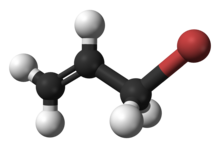


| |

| |
| Names | |
|---|---|
| Preferred IUPAC name
3-Bromoprop-1-ene | |
| Other names
Allyl bromide | |
| Identifiers | |
| |
3D model (JSmol) |
|
| ChemSpider |
|
| ECHA InfoCard | 100.003.134 |
| EC Number |
|
PubChem CID |
|
| RTECS number |
|
| UNII | |
| UN number | 1099 |
CompTox Dashboard (EPA) |
|
| |
| |
| Properties | |
| C3H5Br | |
| Molar mass | 120.977 g·mol−1 |
| Appearance | Clear to light yellow liquid |
| Odor | Unpleasant, irritating, pungent |
| Density | 1.398 g/cm3 |
| Melting point | −119 °C (−182 °F; 154 K) |
| Boiling point | 71 °C (160 °F; 344 K) |
| 0.38 g/100 g H2O[1] | |
| log P | 1.79[1] |
| Vapor pressure | 18.6 kPa |
| −58.6·10−6cm3·mol−1[1] | |
Refractive index (nD) |
1.4697 (20 °C, 589.2 nm) |
| Viscosity | 0.471 cP[1] |
| ≈1.9 D[1] | |
| Thermochemistry | |
Std enthalpy of |
12.2 kJ·mol−1 (liquid) 45.2 kJ·mol−1 (gas)[1] |
Enthalpy of vaporization (ΔfHvap) |
32.73 kJ·mol−1[1] |
| Hazards | |
| GHS labelling: | |
    
| |
| Danger | |
| H225, H301, H314, H330, H331, H340, H350, H400 | |
| P201, P202, P210, P233, P240, P241, P242, P243, P260, P261, P264, P270, P271, P273, P280, P281, P284, P301+P310, P301+P330+P331, P303+P361+P353, P304+P340, P305+P351+P338, P308+P313, P310, P311, P320, P321, P330, P363, P370+P378, P391, P403+P233, P403+P235, P405, P501 | |
| NFPA 704 (fire diamond) | |
| Flash point | −2 to −1 °C |
| 280 °C (536 °F; 553 K) | |
| Explosive limits | 4.3–7.3 % |
Threshold limit value (TLV) |
0.1 ppm[1] (TWA), 0.2 ppm[1] (STEL) |
| Safety data sheet (SDS) | MSDS at Oxford University |
| Related compounds | |
Related compounds |
Allyl chloride Allyl iodide |
Except where otherwise noted, data are given for materials in their standard state (at 25 °C [77 °F], 100 kPa). | |
Allyl bromide (3-bromopropene) is an organic halide. It is an alkylating agent used in synthesis of polymers, pharmaceuticals, perfumes[2] and other organic compounds. Allyl bromide is a colorless liquid, although commercial samples appear yellow or brown. It is an irritant and a potentially dangerous alkylating agent. Allyl bromide is more reactive but more expensive than allyl chloride, and these considerations guide its use.[3]
Allyl bromide is produced commercially from allyl alcohol and hydrobromic acid:[3]
It can also be prepared by the halogen-exchange reaction between allyl chloride and hydrobromic acid or by the allylic brominationofpropene.[3]
Allyl bromide can be also produced by reacting allyl alcohol and pure bromine.
Br2+ CH2=CHCH2OH → CH2=CHCH2Br + HBr + H2O
Allyl bromide is an electrophilic alkylating agent.[4] It reacts with nucleophiles, such as amines, carbanions, alkoxides, etc., to introduce the allyl group:
It is used in the synthesis of compounds containing the allyl functionality, such as the pharmaceuticals methohexital, secobarbital and thiamylal.[3]
Allyl bromide reacts with magnesium metal in dry ether to form allylmagnesium bromide, a Grignard reagent:[5]
Allyl bromide reacts with benzene and a Lewis acid to make Allyl Benzene
C6H6 + CH2=CHCH2Br (FeCl3/AlCl3)→ C₆H₅CH₂CH=CH₂
This reaction is particurarly useful in pharmacy and can be used to make many pharamacueticals such as amphetamines
{{cite book}}: CS1 maint: location missing publisher (link) CS1 maint: others (link)
{{cite journal}}: CS1 maint: multiple names: authors list (link)